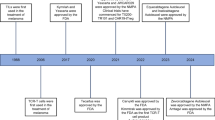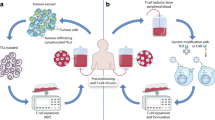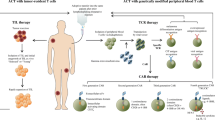Abstract
The development of immune-based approaches for the treatment of cancer has been actively investigated for many years. One strategy that has emerged as a potentially effective strategy for the treatment of aggressive established malignancies is adoptive T cell therapy. The power of this approach has been repeatedly observed in preclinical animal models. However, moving from homogeneous animal models to the heterogeneous human clinical setting has been very difficult. It is only in recent times that we have been able to pinpoint the problems of the clinical translation of adoptive T cell therapy. Some of the major problems are sources of tumor-specific T cells, ex vivo expansion, persistence, and anti-tumor activity. This review overviews the nature of these problems and some of the emerging solutions.



Similar content being viewed by others
References
Ho WY, Blattman JN, Dossett ML, Yee C, Greenberg PD (2003) Adoptive immunotherapy: engineering T cell responses as biologic weapons for tumor mass destruction. Cancer Cell 3:431–437
Ho WY, Yee C, Greenberg PD (2002) Adoptive therapy with CD8(+) T cells: it may get by with a little help from its friends. J Clin Invest 110:1415–1417
Cheever MA, Chen W (1997) Therapy with cultured T cells: principles revisited. Immunol Rev 157:177–194
Dudley ME, Wunderlich JR, Robbins PF et al (2002) Cancer regression and autoimmunity in patients after clonal repopulation with antitumor lymphocytes. Science 298:850–854
Disis ML, Knutson KL, Schiffman K, Rinn K, McNeel DG (2000) Pre-existent immunity to the HER-2/neu oncogenic protein in patients with HER-2/neu overexpressing breast and ovarian cancer. Breast Cancer Res Treat 62:245–252
Dutoit V, Rubio-Godoy V, Pittet MJ, et al. (2002) Degeneracy of antigen recognition as the molecular basis for the high frequency of naive A2/Melan-a peptide multimer(+) CD8(+) T cells in humans. J Exp Med 196:207–216
Germeau C, Ma W, Schiavetti F et al (2005) High frequency of antitumor T cells in the blood of melanoma patients before and after vaccination with tumor antigens. J Exp Med 201:241–248
Mocellin S, Mandruzzato S, Bronte V, Lise M, Nitti D (2004) Part I: vaccines for solid tumours. Lancet Oncol 5:681–689
Choi C, Witzens M, Bucur M et al (2005) Enrichment of functional CD8 memory T cells specific for MUC1 in bone marrow of patients with multiple myeloma. Blood 105:2132–2134
Feuerer M, Rocha M, Bai L et al (2001) Enrichment of memory T cells and other profound immunological changes in the bone marrow from untreated breast cancer patients. Int J Cancer 92:96–105
Knutson KL, Schiffman K, Disis ML (2001) Immunization with a HER-2/neu helper peptide vaccine generates HER- 2/neu CD8 T-cell immunity in cancer patients. J Clin Invest 107:477–484
Disis ML, Gooley TA, Rinn K et al (2002) Generation of T-cell immunity to the her-2/neu protein after active immunization with HER-2/neu Peptide-based vaccines. J Clin Oncol 20:2624–2632
Knutson KL, Disis ML (2004) IL-12 enhances the generation of tumour antigen-specific Th1 CD4 T cells during ex vivo expansion. Clin Exp Immunol 135:322–329
Gately MK, Wilson DE, Wong HL (1986) Synergy between recombinant interleukin 2 (rIL 2) and IL 2-depleted lymphokine-containing supernatants in facilitating allogeneic human cytolytic T lymphocyte responses in vitro. J Immunol 136:1274–1282
Wolf SF, Temple PA, Kobayashi M et al (1991) Cloning of cDNA for natural killer cell stimulatory factor, a heterodimeric cytokine with multiple biologic effects on T and natural killer cells. J Immunol 146:3074–3081
Gately MK, Desai BB, Wolitzky AG et al (1991) Regulation of human lymphocyte proliferation by a heterodimeric cytokine, IL-12 (cytotoxic lymphocyte maturation factor). J Immunol 147:874–882
Uherova P, Connick E, MaWhinney S, Schlichtemeier R, Schooley RT, Kuritzkes DR (1996) In vitro effect of interleukin-12 on antigen-specific lymphocyte proliferative responses from persons infected with human immunodeficiency virus type 1. J Infect Dis 174:483–489
McFarland EJ, Harding PA, MaWhinney S, Schooley RT, Kuritzkes DR (1998) In vitro effects of IL-12 on HIV-1-specific CTL lines from HIV-1- infected children. J Immunol 161:513–519
Trinchieri G (1993) Interleukin-12 and its role in the generation of TH1 cells. Immunol Today 14:335–338
Salazar LG, Fikes J, Southwood S et al (2003) Immunization of cancer patients with HER-2/neu-derived peptides demonstrating high-affinity binding to multiple class II alleles. Clin Cancer Res 9:5559–5565
Tan JT, Dudl E, LeRoy E et al (2001) IL-7 is critical for homeostatic proliferation and survival of naive T cells. Proc Natl Acad Sci USA 98:8732–8737
Schultze JL, Seamon MJ, Michalak S, Gribben JG, Nadler LM (1997) Autologous tumor infiltrating T cells cytotoxic for follicular lymphoma cells can be expanded in vitro. Blood 89:3806–3816
Tsai V, Kawashima I, Keogh E, Daly K, Sette A, Celis E (1998) In vitro immunization and expansion of antigen-specific cytotoxic T lymphocytes for adoptive immunotherapy using peptide-pulsed dendritic cells. Crit Rev Immunol 18:65–75
Ma A, Boone DL, Lodolce JP (2000) The pleiotropic functions of interlukin 15: not so interlukin 2-like after all. J Exp Med 191:753–756
Waldmann TA, Dubois S, Tagaya Y (2001) Contrasting roles of IL-2 and IL-15 in the life and death of lymphocytes: implications for immunotherapy. Immunity 14:105–110
Schluns KS, Lefrancois L (2003) Cytokine control of memory T-cell development and survival. Nat Rev Immunol 3:269–279
Zeng R, Spolski R, Finkelstein SE et al (2005) Synergy of IL-21 and IL-15 in regulating CD8+ T cell expansion and function. J Exp Med 201:139–148
Vonderheide RH, June CH (2003) A translational bridge to cancer immunotherapy: exploiting costimulation and target antigens for active and passive T cell immunotherapy. Immunol Res 27:341–356
Dang Y, Disis ML, Long A, Bonyhadi M, Knutson KL (2004) A novel rapid expansion methods for generating antigen-specific T cell lines for adoptive T cell therapy. Proc AACR 45:(Abstract)
Maus MV, Kovacs B, Kwok WW et al (2004) Extensive replicative capacity of human central memory T cells. J Immunol 172:6675–6683
Levine BL, Bernstein WB, Connors M, et al. (1997) Effects of CD28 costimulation on long-term proliferation of CD4+ T cells in the absence of exogenous feeder cells. J Immunol 159:5921–5930
Shi Y, Evans JE, Rock KL (2003) Molecular identification of a danger signal that alerts the immune system to dying cells. Nature 425:516–521
Hu DE, Moore AM, Thomsen LL, Brindle KM (2004) Uric acid promotes tumor immune rejection. Cancer Res 64:5059–5062
Haddad H, Windgassen D, Ramsborg CG, Paredes CJ, Papoutsakis ET (2004) Molecular understanding of oxygen-tension and patient-variability effects on ex vivo expanded T cells. Biotechnol Bioeng 87:437–450
Dudley ME, Wunderlich JR, Yang JC et al (2002) A phase I study of nonmyeloablative chemotherapy and adoptive transfer of autologous tumor antigen-specific T lymphocytes in patients with metastatic melanoma. J Immunother 25:243–251
Dudley ME, Wunderlich J, Nishimura MI, et al. (2001) Adoptive transfer of cloned melanoma-reactive T lymphocytes for the treatment of patients with metastatic melanoma. J Immunother 24:363–373
Yee C, Thompson JA, Byrd D et al (2002) Adoptive T cell therapy using antigen-specific CD8+ T cell clones for the treatment of patients with metastatic melanoma: in vivo persistence, migration, and antitumor effect of transferred T cells. Proc Natl Acad Sci USA 99:16168–16173
Wherry EJ, Barber DL, Kaech SM, Blattman JN, Ahmed R (2004) Antigen-independent memory CD8 T cells do not develop during chronic viral infection. Proc Natl Acad Sci USA 101:16004–16009
Powell DJ Jr, Dudley ME, Robbins PF, Rosenberg SA (2005) Transition of late-stage effector T cells to CD27+ CD28+ tumor-reactive effector memory T cells in humans after adoptive cell transfer therapy. Blood 105:241–250
Wang LX, Kjaergaard J, Cohen PA, Shu S, Plautz GE (2004) Memory T cells originate from adoptively transferred effectors and reconstituting host cells after sequential lymphodepletion and adoptive immunotherapy. J Immunol 172:3462–3468
Schiavoni G, Mattei F, Di Pucchio T et al (2000) Cyclophosphamide induces type I interferon and augments the number of CD44(hi) T lymphocytes in mice: implications for strategies of chemoimmunotherapy of cancer. Blood 95:2024–2030
Lutsiak ME, Semnani RT, De Pascalis R, Kashmiri SV, Schlom J, Sabzevari H (2005) Inhibition of CD4+25+ T regulatory cell function implicated in enhanced immune response by low-dose cyclophosphamide. Blood 105:2862–2868
Matar P, Rozados VR, Gervasoni SI, Scharovsky OG (2001) Down regulation of T-cell-derived IL-10 production by low-dose cyclophosphamide treatment in tumor-bearing rats restores in vitro normal lymphoproliferative response. Int Immunopharmacol 1:307–319
North RJ (1982) Cyclophosphamide-facilitated adoptive immunotherapy of an established tumor depends on elimination of tumor-induced suppressor T cells. J Exp Med 155:1063–1074
Liyanage UK, Moore TT, Joo HG et al (2002) Prevalence of regulatory T cells is increased in peripheral blood and tumor microenvironment of patients with pancreas or breast adenocarcinoma. J Immunol 169:2756–2761
Curiel TJ, Coukos G, Zou L, et al. (2004) Specific recruitment of regulatory T cells in ovarian carcinoma fosters immune privilege and predicts reduced survival. Nat Med 10:942–949
Knutson KL, Disis ML (2005) Tumor antigen-specific T helper cells in cancer immunity and immunotherapy. Cancer Immunol Immunother DOI:10.1007/s00262–004–0653–2, 2005;On-Line
Knutson KL, Schiffman K, Cheever MA, Disis ML (2002) Immunization of cancer patients with a HER-2/neu, HLA-A2 peptide, p369–377, results in short-lived peptide-specific immunity. Clin Cancer Res 8:1014–1018
Matloubian M, Concepcion RJ, Ahmed R (1994) CD4+ T cells are required to sustain CD8+ cytotoxic T-cell responses during chronic viral infection. J Virol 68:8056–8063
Weninger W, Crowley MA, Manjunath N, von Andrian UH (2001) Migratory properties of naive, effector, and memory CD8(+) T cells. J Exp Med 194:953–966
Palmer DC, Balasubramaniam S, Hanada K et al (2004) Vaccine-stimulated, adoptively transferred CD8+ T cells traffic indiscriminately and ubiquitously while mediating specific tumor destruction. J Immunol 173:7209–7216
Vitale M, Pelusi G, Taroni B et al (2005) HLA class I antigen down-regulation in primary ovary carcinoma lesions: association with disease stage. Clin Cancer Res 11:67–72
Romero JM, Jimenez P, Cabrera T et al (2005) Coordinated downregulation of the antigen presentation machinery and HLA class I/beta2-microglobulin complex is responsible for HLA-ABC loss in bladder cancer. Int J Cancer 113:605–610
Saio M, Teicher M, Campbell G, Feiner H, Delgado Y, Frey AB (2004) Immunocytochemical demonstration of down regulation of HLA class-I molecule expression in human metastatic breast carcinoma. Clin Exp Metastasis 21:243–249
Chang CC, Campoli M, Ferrone S (2003) HLA class I defects in malignant lesions: what have we learned? Keio J Med 52:220–229
Allavena P, Peccatori F, Maggioni D, et al. (1990) Intraperitoneal recombinant gamma-interferon in patients with recurrent ascitic ovarian carcinoma: modulation of cytotoxicity and cytokine production in tumor-associated effectors and of major histocompatibility antigen expression on tumor cells. Cancer Res 50:7318–7323
Pujade-Lauraine E, Guastalla JP, Colombo N et al (1996) Intraperitoneal recombinant interferon gamma in ovarian cancer patients with residual disease at second-look laparotomy. J Clin Oncol 14:343–350
Propper DJ, Chao D, Braybrooke JP et al (2003) Low-dose IFN-gamma induces tumor MHC expression in metastatic malignant melanoma. Clin Cancer Res 9:84–92
zum Buschenfelde CM, Hermann C, Schmidt B, Peschel C, Bernhard H (2002) Antihuman epidermal growth factor receptor 2 (HER2) monoclonal antibody trastuzumab enhances cytolytic activity of class I-restricted HER2-specific T lymphocytes against HER2-overexpressing tumor cells. Cancer Res 62:2244–2247
Viguier M, Lemaitre F, Verola O et al (2004) Foxp3 expressing CD4+CD25(high) regulatory T cells are overrepresented in human metastatic melanoma lymph nodes and inhibit the function of infiltrating T cells. J Immunol 173:1444–1453
Jones E, Dahm-Vicker M, Simon AK et al (2002) Depletion of CD25+ regulatory cells results in suppression of melanoma growth and induction of autoreactivity in mice. Cancer Immun 2:1
Curiel TJ, Wei S, Dong H et al (2003) Blockade of B7-H1 improves myeloid dendritic cell-mediated antitumor immunity. Nat Med 9:562–567
Almand B, Clark JI, Nikitina E et al (2001) Increased production of immature myeloid cells in cancer patients: a mechanism of immunosuppression in cancer. J Immunol 166:678–689
Zou W, Machelon V, Coulomb-L’Hermin A, et al. (2001) Stromal-derived factor-1 in human tumors recruits and alters the function of plasmacytoid precursor dendritic cells. Nat Med 7:1339–1346
Sun YX, Wang J, Shelburne CE et al (2003) Expression of CXCR4 and CXCL12 (SDF-1) in human prostate cancers (PCa) in vivo. J Cell Biochem 89:462–473
Muller A, Homey B, Soto H et al (2001) Involvement of chemokine receptors in breast cancer metastasis. Nature 410:50–56
Nagasawa T, Hirota S, Tachibana K et al (1996) Defects of B-cell lymphopoiesis and bone-marrow myelopoiesis in mice lacking the CXC chemokine PBSF/SDF-1. Nature 382:635–638
Gorelik L, Flavell RA (2002) Transforming growth factor-beta in T-cell biology. Nat Rev Immunol 2:46–53
Hodi FS, Mihm MC, Soiffer RJ et al (2003) Biologic activity of cytotoxic T lymphocyte-associated antigen 4 antibody blockade in previously vaccinated metastatic melanoma and ovarian carcinoma patients. Proc Natl Acad Sci USA 100:4712–4717
Author information
Authors and Affiliations
Corresponding author
Additional information
This article is a symposium paper from the conference “Progress in Vaccination against Cancer 2004 (PIVAC 4)”, held in Freudenstadt-Lauterbad, Black Forest, Germany, on 22–25 September 2004
Grant support: This grant was supported by K01-CA100764 (KLK) and R01-CA85374 (MLD)
Rights and permissions
About this article
Cite this article
Knutson, K.L., Wagner, W. & Disis, M.L. Adoptive T cell therapy of solid cancers. Cancer Immunol Immunother 55, 96–103 (2006). https://doi.org/10.1007/s00262-005-0706-1
Received:
Accepted:
Published:
Issue Date:
DOI: https://doi.org/10.1007/s00262-005-0706-1




